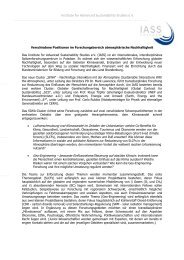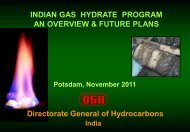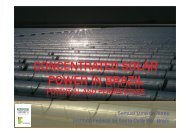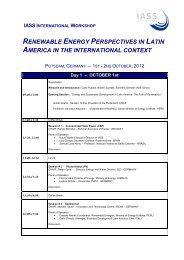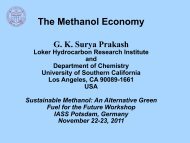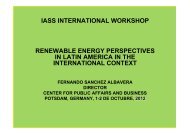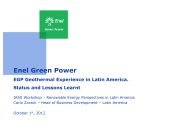Create successful ePaper yourself
Turn your PDF publications into a flip-book with our unique Google optimized e-Paper software.
What is a Gas Hydrate?• Crystalline solid consisting ofgas molecules, usuallymethane, each surrounded by acage of water molecules– One volume hydrate typicallyequivalent to 160 volumes methanegas• Occur abundantly in nature– Arctic regions and in marinesedimentsT. Collett
Filling pores in coarse grainedsandGas Hydrates in NatureWhat they look like…in natureMassive lenses in mudsNodulesFilling pores in fine-grained marinesandsThin veins in mudsMassive mounds on Sea-floorT. Collett
Methane Hydrate Stability• Temperatures and ModeratePressures– Temperatures above & below 0°C• Stable– Arctic associated with permafrost– Marine sediments (> 500m deep)• Requires Gas Source– Biogenic– ThermogenicT. Collett
Gas Hydrate OccurrencesT. Collett
National Gas Hydrate Research ProgramsUSA: USDOE's Methane Hydrate Research and Development Program[15 M/y] Japan: National R&D Program for Methane Hydrate Resources in Japan -Ministry of International Trade and Industry (the current Ministry of Economy,Trade, and Industry – METI), with the Japan National Oil Corporation (the currentJapan Oil, Gas and Metals Corporation) [30 M/y; Nankai Testing Program 1,000 M]India: National Gas Hydrate Program - Ministry of Petroleum and Natural Gas,with the Directorate General of Hydrocarbons (DGH) [2-3 M/y; NGHP01 32 M]Canada: New Canadian Gas Hydrate Research Program – Natural ResourcesCanada, Earth Sciences Sector (Geological Survey of Canada) [2 M/y]China: China National Gas Hydrate Program – the China Geological Surveythrough the Guangzhou Marine Geologic Survey of China [5-20 M/y; GMGS01 25 M]Korea: Gas Hydrate R&D Organization – Ministry of Knowledge Economy (MKE),with Korea Institute of Geoscience and Mineral Resources (KIGAM) and KoreaNational Oil Corporation (KNOC) [5-10 M/y; UBGH02 30 M]Other programs: Russia, Germany, Taiwan, Great Britain, France, Norway, Mexico,Chile, Columbia, Brazil, New ZealandT. Collett
GH-Saturated conglomerate –NW Canada (Mallik)Gas Hydrate sample –2002 Mallik GasHydrate ProductionTestThe Gas Hydrates Resource PyramidDistribution of huge in-place resourceAMallik -GH-saturated 2002 turbidite –Nankai troughBGH-saturated fractured clays –Bay of BengalABCDECMassive GH seafloor mound –Gulf of MexicoDBoswell and Collett, 2006Data SourcesA: Collett, 1993; Collett, 1995B: MMS, 2008C: Unassessed (India, Korea expeditions)D: UnassessedE: Collett, 1995• increasing in-place• decreasing reservoir quality• increasing technical challenges• decreasing % recoverableT. Collett
Gas Hydrate Production Concepts• Depressurization– Analogous to CBM• Heating• Inhibitor Injection• ChemicalExchange– CO 2 sequestration• A combination– What works bestin local situationT. Collett
Major Advancements TowardGas Hydrate Production• 2002: Japan-Canada-US-Germany-India Mallik well,Mackenzie Delta, Northwest Territories, Canada– Pressure-drawdown and thermal stimulation experiments• 2008: DOE-BP Milne Point well, Alaska North Slope– Confirm gas flow from depressurization– Collected temperature, pressure and flow data for improvedcomputer modeling• 2007-2008: Canada-Japan Mallik production test– Six-day depressurization test produced continuous, strong flow• 2011-2012: Ignik Sikumi CO 2 displacement test– Determine injection characteristics and exchange rates• 2012-2013: Planned Alaska North Slope long-termproduction test– Determine gas flow and reservoir response to months-long tomulti-year production using several different productiontechnologiesT. Collett
CSM Natural Gas Hydrates Group Research ac?vi?es & vision for path forward
CSM Hydrates in Nature Group• Tim ColleD (USGS): Hydrate geology, field explora?on/drilling • Mike Batzle, Manika Prasad, André Revil (Rock and Geophysics): Rock proper?es, microstructural, fluid proper?es • Yu-‐Shu <strong>Wu</strong> and Xiaolong Yin (Petroleum Eng.): Reservoir engineering and simula?ons, exper?se on TOUGH-‐Hydrate • Ning Lu (Civil Eng.): Stability of natural slopes and par?ally wet soils • <strong>David</strong> <strong>Wu</strong> (Chem. Eng./Chem.): Mechanics and thermodynamics of mul?phase granular systems • Amadeu Sum, Carolyn Koh, Dendy Sloan (Chem. Eng.): Hydrate synthesis and characteriza?on, stability, forma?on/dissocia?on, aggrega?on, micromechanical tes?ng, modeling
CSM Vision for Path Forward inNatural Hydrates Research• Research ac?vi?es and opportuni?es – Provide concepts underlying forma?on/dissocia?on – Applica?on of concepts in the field Geology and Petrology • Geologic controls on natural hydrates • Lithologic controls on hydrate distribu?on Field Characteriza?on and Sensing • Well log characteriza?on • Seismic and electrical geophysics Pore & Sediment Scale Proper?es • Micro X-‐ray CT • Elas?c veloci?es & electrical resis?vity • Mechanical proper?es for par?al satura?on • Interfacial pore-‐scale phenomena • Pore-‐scale transport and permeability Produc?on Modeling and Tes?ng • Thermodynamics and kine?cs of dissocia?on • Lab and pilot-‐scale tes?ng • Reservoir modeling
Geology and Petrology of Natural Hydrates• Tim Colle^ (USGS) • Mike Batzle, Manika Prasad, André Revil, Marisa Rydzy (CSM)
Controls on the Occurrence Gas Hydrate-Gas Hydrate Petroleum System-- Formation temperature- Formation pressure- Pore water salinity- Gas chemistry- Availability of gas and water (source)- Gas and water migration pathways- Presence of reservoir rocks- Trap and sealsT. Collett
Gas Hydrate Petroleum SystemExample: Gas MigrationMethane, along with other hydrate forming gases, migrateswithin a sedimentary section by one of three processes:(1) Diffusion(2) Gas dissolved within migrating water(3) As a bubble ― a separate gas phaseIODP Leg 204 – Hydrate RidgeGasHyndman and Davis, 1992 Tréhu et al., 2004T. Collett
Field Characterization and Sensing• Mike Batzle, Manika Prasad, André Revil, Marisa Rydzy (Rock and Geophysics)
Geophysical & Rock Property MeasurementsM. BatzleLinking Geophysical / Geomechanical Field and Laboratory Measurements
Rock Property MeasurementsM. Batzle Combine Laboratory measurements with in situ evaluation Mechanical Testing Sonic velocities Electrical resistivity Porosity LogsEmpirical relationships topredict in situ mechanicalproperties and response toproduction Investigation of natural and laboratory-formed samples Combining petrophysical analyses w/ imaging techniquesZodack
Experimental Experimental Setups SetupsBatzle, Revil, Rydzy1. Ultrasonic velocity 1. Ultrasonic measurements velocity measurements 2. Micro X-ray CT 2. scanner Micro X-ray CT scanner[Add Photograph] [Add Photograph]3. SIP combined with 3. SIP ultrasonics combined with ultrasonics 4. Low Frequency 4. velocity Low Frequency device* velocity device2
Results COP Summer Internship 2010S wi V pBatzle, Revil, RydzyStrong Dependence on Initial Water Saturation (S wi )6
Results COP Summer Internship 2010Batzle, Revil, RydzyS wi V pV SLinear Increase in Velocity with Increasing Saturation7
Conceptual PictureBatzle, Revil, Rydzy Effect of Water Distribution and Saturation of Ultrasonic Velocities
Spectral Induced PolarizationBatzle, Revil, RydzyPreliminary results for THF-H 2 O (1:22) saturated Ottawa sand F110
Pore and Sediment Scale Properties• Mike Batzle, Manika Prasad, André Revil, Marisa Rydzy (Rock and Geophysics) Xiaolong Yin (Petroleum Eng.) • Ning Lu (Civil Eng.) • <strong>David</strong> <strong>Wu</strong>, Ben Zeidman (Chem. Eng./Chemistry) • Amadeu Sum, Carolyn Koh, Dendy Sloan, Zach Aman (Chem. Eng.)
Microstructural Modeling of Hydrate inSedimentHydrate/water/gas distributionMechanical PropertiesConnection with MicromechanicalForce Experiments
Grain-Scale Modeling and X-ray CTCharacterization of Stress-Bearing StructureX-‐ray microtomography of par?ally wet soil Stresses are supported by• grain-grain contacts• pore fluid pressure• interfacial tension (capillarity)Cohesive• cementing of grains by ice/hydrateCohesive network depends on• water & gas content• ice/hydrate formation kinetics vs pore size• thermodynamics & historyCarry out simulation & developtheory to characterize networkstrength. The structures will bevalidated by X-ray microtomography.Monte Carlo simulation ofcapillary bridge formationSolid hydrate bridges canfreeze and sustain stress
Micro X-Ray Computed TomographyBatzle, Revil, Rydzy1 mm20 min 40 min 60 min80 min 100 min 120 minMXCT Images of THF Hydrate (1:22) dissociating in Glass Beads
Monte Carlo simulation approach can capturewater distribution and accompanying stressesGood convergenceCapillary stress canbe computed forliquid bridgesCompare withmicromechanicalforce measurementsAgrees withtheoryStrength for hydrate phase can be modeledwith hydrate mechanical constitutive laws(Lu, Lusk, Zeidman & <strong>Wu</strong>, Geophysical Res Le^ 2010)
Prediction of water distribution and capillarystress for realistic grain distributionsO^awa Sand Sample Top: Micro X-‐ray CT Bo^om: Simula?on Increasing water saturationSimulation can predict pore-scalewater distribution and resultingmacroscopic properties(Lu, Lusk, Zeidman & <strong>Wu</strong>, Geophysical Res Le^ 2010) Capillary Pressure (Pa)6500600055005000450040003500300025002000150010005000Monte Carlo SimulationExperimental0 20 40 60 80 100Saturation (%)
Lab Measurements on Sediment StrengthMeasurements of tensile strengthon samples with varyingTensile Strength ApparatusAdjustable dead weight (steel)Specimen system• Grain size• Water/gas content• Hydrate conversionLinear ball bearings18.9 oBed (aluminum)Can test capillary strengthThen freeze to test strength dueto ice/hydrate cementingHingeDigital angle meterBase (aluminum)Screw jackClamps with wing nutsRubber sleeveAluminum sleeveSpecimen SystemSpecimen
Interfacial Tensiometer (IFT)Measures Surface Tension, Contact AngleCamera with high-intensity lightCurvature analyzed by sodware Hydrate particlesHypothesis from Aspenes (2009)Water-wetOil-wetOil-Wet SurfaceWater-Wet SurfaceCMC = Critical Micelle ConcentrationWater-WetOil-WetWater-Wet
Micromechanical Force (MMF)Apparatus Directly Measures Adhesion ForceCellInvertedMicroscope
Micromechanical Force (MMF)Apparatus Directly Measures Adhesion ForceHooke’s Law= Cohesive Force= spring constantof LHS cantilever= displacementat break-point1Calibra?on in each experiment for unique roughness, humidity ! D23
Production Modeling and Testing• Tim Colle^ (USGS) • Yu-‐Shu <strong>Wu</strong> and Xiaolong Yin (Petroleum Eng.) • Amadeu Sum, Carolyn Koh, Dendy Sloan, Prasad Kerkar (Chem. Eng.)
Energy Potential & SafetyAssessments of Energy Productionfrom Gas Hydrates in SedimentTOUGH-modelingCO 2 /CH 4 Exchange
Reservoir Modeling – Y.-S. <strong>Wu</strong>Using TOUGH+Hydrate (G. Moridis)1. Components 2. Phases• (1) H 2 O • (2) CH 4 • (3) Hydrate (*) • (4) Salt • (5) Inhibitor • (6) Heat (1) AqueousH 2 O, CH 4 , CH 4 , S, I(2) GasCH 4 , H 2 O, I(3) Solid-HydrateCH 4 .N m H 2 0New hydration P-TrelationshipsBlue: Minimum necessary (*) for kine?c dissocia?on 26 Possible phasecombinations(4) Solid-IceH 2 OTOUGH+Hydrate capable of handling (a) equilibrium or kinetic dissociation, and (b)all possible dissociation mechanisms (depressurization, thermal stimulation,inhibitor effects, and combinations)
TOUGH-Hydrate ModelingHigh production rates:Short-term and long-termVariable mass production rate:A NECESSITY
CO 2 Sequestration with CH 4 Exchange• Study kinetics and extentof CO 2 /CH 4 exchange• Use bench-scale setup• Quantify hydrate volumefraction & composition• Measure composition ofeffluent stream
In situ CH 4 -CO 2 Replacement – Set upComposi_onal Analysis Methane Hydrate Forma_on Liquid CO 2 Flooding In-‐line gas chromatograph High P cell High P Ruska pump for CO 2 injec_on
Experimental methodology – Mass balanceCH 4 hydrateFormationSweeping withliquid CO 2“Soaking” withliquid CO 2 flowDissociation withliquid CO 2 flown CH4sweepn CH4soakn CH4hyd-finaln CH4gas+n CH4hydn CH4hyd*n CH4hyd**CO 2(l)CO 2(l)CO 2(l)Preliminary result: increased flow rate enhances exchangeExpt. Sweeping %n CH4-‐sweep Soaking %n CH4-‐soak %n CH4-‐dissn. 1 9 hrs, 30 cc/hr 14.5 24hrs, closed n.a. 88.1 2 9 hrs, 30 cc/hr 18.0 24 hrs, 3.75-‐7.5 cc/hr 10.2 75.5
Summary• Overview of Natural Gas Hydrates R&D Issues • CSM Natural Gas Hydrates Group – Research vision & ac?vi?es for path forward
CSM Vision for Path Forward inNatural Hydrates Research• Research ac?vi?es and opportuni?es – Provide concepts underlying forma?on/dissocia?on – Applica?on of concepts in the field Geology and Petrology • Geologic controls on natural hydrates • Lithologic controls on hydrate distribu?on Field Characteriza?on and Sensing • Well log characteriza?on • Seismic and electrical geophysics Pore & Sediment Scale Proper?es • Micro X-‐ray CT • Elas?c veloci?es & electrical resis?vity • Mechanical proper?es for par?al satura?on • Interfacial pore-‐scale phenomena • Pore-‐scale transport and permeability Produc?on Modeling and Tes?ng • Thermodynamics and kine?cs of dissocia?on • Lab and pilot-‐scale tes?ng • Reservoir modeling
Thanks for Support to:• DeepStar Consor?um of Energy Companies • Na?onal Undersea Research Program • Na?onal Science Founda?on • US Department of Energy • CSM Hydrate Consor?um




